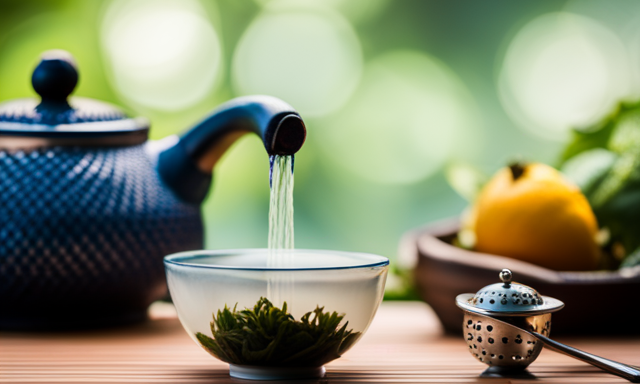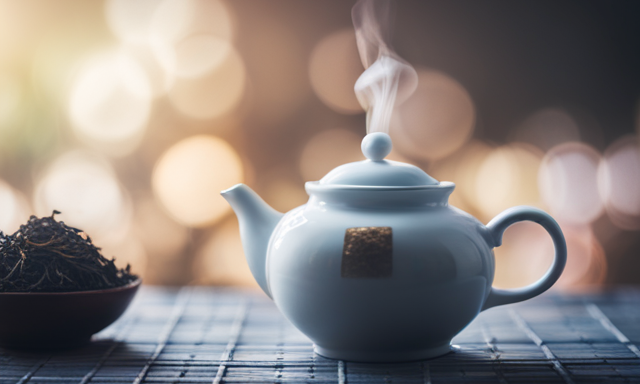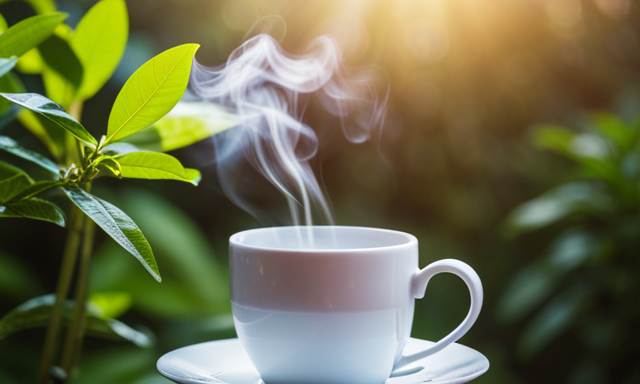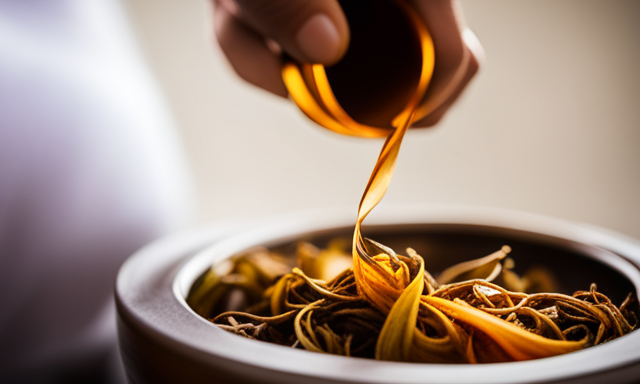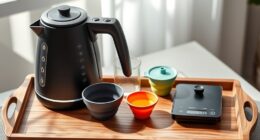Are you searching for the perfect accompaniment to your oolong tea, that will elevate your tea-drinking experience to a whole new level? Look no further, my fellow tea enthusiasts, for I have discovered the secrets to creating tantalizing combinations that will awaken your taste buds and leave you craving for more.
In this article, I will guide you through a journey of flavor exploration, where we will explore the art of mixing oolong tea with various ingredients that will enhance its natural richness and bring out its unique characteristics.
From the zesty burst of citrus to the delicate notes of fresh mint, we will delve into a world of possibilities that will surprise and delight your senses.
So, join me as we embark on this delightful adventure, and let your taste buds be tantalized by the myriad of flavors that await you in the world of oolong tea mixology.
Key Takeaways
- Mixing oolong tea with various ingredients enhances the flavor and creates a sensory experience.
- Berries and oolong tea create a potent health-boosting concoction and add a fruity taste to the tea.
- Blending oolong tea with black tea adds depth and richness, enhancing the fruity taste of mixed berries.
- Pairing oolong tea with dark chocolate or adding cinnamon creates a delightful indulgence and enhances the overall flavor profile.
Add a Twist of Citrus
Adding a twist of citrus to your oolong tea is a great way to enhance its flavor. It brings a refreshing burst of flavor that will transport you to a sunny tropical paradise with every sip. There are a variety of zesty citrus combinations you can try to tantalize your taste buds.
For a classic and invigorating blend, squeeze a slice of fresh lemon into your oolong tea. The tangy and bright flavor of lemon pairs perfectly with the earthy notes of the tea.
If you’re looking for a unique twist, consider adding a splash of orange juice or a twist of lime to your tea. These unexpected citrus pairings will take your oolong tea to new heights of deliciousness. The vibrant citrus flavors perfectly complement the earthy notes of the oolong tea, creating a harmonious and refreshing beverage.
Now that we’ve explored the wonderful world of citrus, let’s move on to the next section and sweeten our tea with honey or agave.
Sweeten with Honey or Agave
To enhance the flavor of your oolong tea, consider sweetening it with the natural sweetness of honey or agave. This will bring a touch of sweetness that will make your taste buds dance to the rhythm of the adage ‘a spoonful of sweetness makes everything more delightful.’
Sweetening your oolong tea with honey or agave adds a subtle complexity to its flavor profile. It complements the rich and earthy notes of the tea leaves. You can also experiment with different sweeteners such as maple syrup, which adds a hint of caramel-like sweetness.
The versatility of oolong tea allows for endless possibilities, and the addition of sweeteners opens up a new world of flavors to explore.
Now, let’s transition into the subsequent section where we’ll explore how to go herbal with fresh mint.
Go Herbal with Fresh Mint
Enhance your oolong tea with the refreshing twist of fresh mint. Add a burst of herbal goodness to your sips. To go minty with peppermint, simply add a few sprigs of this invigorating herb to your tea. Let it steep for a few minutes. The cool, minty flavor will mingle beautifully with the earthy notes of oolong. This creates a harmonious blend that is both refreshing and soothing.
For an extra touch of floral aroma, try a touch of lavender. This delicate flower adds a subtle sweetness and a hint of relaxation to your tea experience. The combination of mint and lavender will transport you to a serene garden. Each sip is a moment of pure bliss.
Now, let’s explore how to enhance your oolong tea with floral notes…
Enhance with Floral Notes
Enhancing your oolong tea with floral notes can elevate the taste and create a delightful sensory experience. Studies have shown that incorporating lavender or rose petals into your oolong tea can enhance relaxation and reduce stress levels.
When paired with oolong tea, lavender provides a soothing blend that is perfect for winding down after a long day. Its delicate aroma and calming properties make it a popular choice for those seeking a moment of tranquility.
On the other hand, adding rose petals to oolong tea adds a romantic touch. The subtle floral flavor of the petals complements the earthy notes of the tea, creating a harmonious and enchanting blend.
Now, let’s explore how to enjoy a creamy addition to your oolong tea.
Enjoy a Creamy Addition
Indulge in the creamy goodness of a velvety addition to your oolong tea. This luscious treat will transport you to a world of pure satisfaction.
For those looking to add a touch of decadence to their tea, consider incorporating a creamy coffee alternative or a frothy milk addition. These options not only enhance the flavor profile of the oolong tea but also provide a luxurious texture that is simply irresistible.
Whether you prefer a silky almond milk or a rich coconut cream, the creamy addition will elevate your tea-drinking experience to new heights. The smoothness and richness of these ingredients complement the earthy notes of the oolong tea, resulting in a harmonious and indulgent blend.
As you savor the creamy infusion, the next section will take you on a journey to explore the vibrant world of fresh berries.
Get Fruity with Fresh Berries
When it comes to enjoying a refreshing cup of oolong tea, why not elevate the experience by adding a burst of fruity flavors?
One delectable option is to muddle in some ripe strawberries, allowing their natural sweetness to infuse into the tea.
For those craving a slightly tangy twist, adding a handful of blueberries or raspberries can provide a delightful burst of flavor.
And for those who simply can’t decide, a blend of mixed berries offers a medley of tastes that will satisfy any palate.
Whether you prefer the subtle sweetness of strawberries or the bold tartness of raspberries, adding fresh berries to your oolong tea is a surefire way to elevate your tea-drinking experience to new heights.
Muddle in Some Ripe Strawberries
Craving a delightful twist to your oolong tea? Chuck in some juicy strawberries and watch the flavors dance a tango on your taste buds. The combination of oolong tea and strawberries not only offers a refreshing and invigorating experience but also provides numerous health benefits. Strawberries are packed with antioxidants that promote heart health and boost the immune system. When paired with oolong tea, these antioxidants work together to fight free radicals and reduce inflammation.
To incorporate oolong tea and strawberries into cocktails, try these three delectable options:
-
Strawberry Oolong Martini: Infuse oolong tea into vodka, muddle fresh strawberries, and add a splash of lime juice for a sophisticated and tangy cocktail.
-
Strawberry Oolong Sangria: Mix oolong tea, diced strawberries, red wine, and a hint of honey for a fruity and refreshing twist on classic sangria.
-
Strawberry Oolong Mocktail: Brew a strong cup of oolong tea, blend it with fresh strawberries, a squeeze of lemon, and a drizzle of honey for a non-alcoholic treat.
If you’re looking to add a handful of blueberries or raspberries to your oolong tea blend, read on to discover more fruity options.
Add a Handful of Blueberries or Raspberries
Boost your oolong tea with a burst of vibrant flavor by sprinkling in a handful of juicy blueberries or raspberries. These luscious fruits not only enhance the taste of the tea, but also provide a beautiful visual appeal. Adding a touch of lavender to the mix adds a subtle floral note that complements the natural sweetness of the berries. To create a harmonious blend, consider experimenting with fruit infusions by combining the tea with mashed blueberries or raspberries. The result is a delightful concoction that tantalizes the taste buds and invigorates the senses. As you sip on this refreshing blend, you’ll enjoy the delicate balance of flavors and the health benefits that these antioxidant-rich berries offer. Now, let’s transition to the next section and explore the idea of trying a blend of mixed berries to further elevate your oolong tea experience.
Try a Blend of Mixed Berries
To enhance your oolong tea experience, why not elevate it by trying a delightful blend of mixed berries? The combination of oolong tea and mixed berries creates a harmonious symphony of flavors that will tantalize your taste buds. Here are four reasons why this blend is a must-try:
-
Burst of sweetness: The natural sweetness of the mixed berries complements the delicate, floral notes of oolong tea, creating a delightful balance of flavors.
-
Antioxidant powerhouse: Berries are packed with antioxidants that promote overall well-being. Combining them with oolong tea, known for its own antioxidant properties, creates a potent health-boosting concoction.
-
Blend with black tea: For an even bolder flavor, consider blending oolong tea with black tea. This combination adds depth and richness to the fruity taste of the mixed berries.
-
Pair with dark chocolate: To take your oolong tea experience to new heights, pair it with a square of dark chocolate. The complex flavors of dark chocolate complement the sweetness of the berries, creating a luxurious treat.
Now, let’s spice it up with cinnamon and discover a whole new dimension of flavor.
Spice it Up with Cinnamon
If you’re looking to add a little extra flavor to your oolong tea, why not try mixing in some warm and comforting cinnamon? Cinnamon not only adds a delightful aroma to your tea, but it also brings numerous health benefits. Studies have shown that cinnamon can help regulate blood sugar levels, reduce inflammation, and improve heart health.
When combined with oolong tea, cinnamon creates a harmonious blend that is both soothing and invigorating. The subtle spiciness of cinnamon complements the earthy and floral notes of oolong, creating a truly delightful experience for your taste buds.
To further explore different tea blends, you can also experiment with herbal infusions that complement the flavors of oolong tea. By infusing your oolong tea with herbs like chamomile or lavender, you can create a soothing and aromatic brew that will transport you to a place of tranquility.
Experiment with Herbal Infusions
When it comes to experimenting with herbal infusions, there are a few key points to consider.
First, blending oolong with green tea can create a unique and refreshing flavor combination.
Second, combining oolong with chamomile or rooibos can add a soothing and calming element to the tea.
And finally, adding a hint of ginger or turmeric can provide a subtle yet invigorating kick to the oolong tea.
These combinations can elevate your oolong tea experience and offer a range of intriguing flavors to explore.
Blend Oolong with Green Tea
Try blending oolong tea with green tea for a delightful and invigorating combination. This pairing brings together the rich, complex flavors of oolong with the fresh, grassy notes of green tea, creating a harmonious blend that is both refreshing and satisfying.
To achieve the perfect balance, experiment with different tea ratios, adjusting the amounts of oolong and green tea until you find the ideal mix for your taste buds.
By blending oolong with white tea, you can further enhance the flavor profile, adding a subtle sweetness and floral undertones. The possibilities are endless, allowing you to create a unique blend that suits your preferences.
Next, we’ll explore how to combine oolong with chamomile or rooibos to create even more delightful tea combinations.
Combine with Chamomile or Rooibos
Blending the delicate floral notes of chamomile or the earthy sweetness of rooibos with oolong creates a mesmerizing dance of flavors that will transport your taste buds to a tranquil oasis. To truly elevate this blend, consider combining it with lavender or peppermint for a soothing and aromatic experience. The calming properties of chamomile and the refreshing kick of peppermint create a harmonious balance with the rich and complex flavors of oolong tea. For an added touch of complexity, try infusing a hint of lemongrass or hibiscus into the blend. The citrusy brightness of lemongrass and the tartness of hibiscus perfectly complement the smoothness of oolong, resulting in a delightful fusion of flavors. And if you’re feeling adventurous, in the next section, we’ll explore the exciting combination of oolong tea with a hint of ginger or turmeric, taking your taste buds on a journey of bold and invigorating sensations.
Try a Hint of Ginger or Turmeric
After exploring the idea of combining oolong tea with chamomile or rooibos, let’s now delve into the intriguing world of incorporating a hint of ginger or turmeric. Both ginger and turmeric are well-known for their health benefits and unique flavors. When added to oolong tea, they create a delightful fusion of tastes that is both refreshing and invigorating.
Here are four reasons why you should consider mixing oolong tea with ginger or turmeric:
- Boosts digestion: Ginger and turmeric have been used for centuries to aid digestion and soothe upset stomachs.
- Reduces inflammation: Both ginger and turmeric possess anti-inflammatory properties that can help alleviate joint pain and promote overall wellness.
- Enhances immune function: Ginger and turmeric are rich in antioxidants, which support a healthy immune system.
- Adds depth of flavor: The subtle spiciness of ginger and earthiness of turmeric perfectly complement the floral notes of oolong tea, creating a harmonious blend of flavors.
Now, let’s explore how adding a nutty flair can further elevate your oolong tea experience.
Add a Nutty Flair
To enhance the nutty flavor of your oolong tea, why not sprinkle in some crushed almonds or stir in a spoonful of creamy peanut butter? These nutty and creamy combinations add a delightful twist to your tea experience. The rich and earthy taste of oolong tea pairs perfectly with the subtle sweetness of almonds or the smoothness of peanut butter.
Incorporate a 3 column and 3 row table to explore various nutty add-ins for your oolong tea:
| Nutty Add-ins | Description | Pairing |
|---|---|---|
| Crushed Almonds | Adds a crunchy texture and nutty flavor | Complements the earthy notes of oolong tea |
| Creamy Peanut Butter | Provides a creamy mouthfeel and nutty taste | Balances the boldness of oolong tea |
| Hazelnut Spread | Imparts a rich and decadent flavor | Enhances the natural sweetness of oolong tea |
Experimenting with unique flavors is a delightful way to elevate your tea-drinking experience. So go ahead and get creative with different combinations to discover your perfect cup of oolong tea.
Transitioning into the next section about ‘get creative with unique flavors,’ there are endless possibilities to explore and enhance the taste of your oolong tea.
Get Creative with Unique Flavors
When it comes to adding unique flavors to oolong tea, I love experimenting with different infusions. One of my favorite ways is to infuse the tea with vanilla bean or extract. This adds a subtle sweetness and a rich aroma.
For a twist, I also enjoy adding a hint of matcha. This gives the tea a vibrant green color and a slightly earthy taste.
And if I’m feeling adventurous, I mix in some chai spice blend. This adds a warm and spicy kick to the oolong tea.
These creative flavor combinations truly elevate the tea-drinking experience and add a nutty flair to my cup.
Infuse with Vanilla Bean or Extract
Infusing oolong tea with the rich and enticing flavor of vanilla bean or extract will leave your taste buds craving more. Vanilla adds a warm and sweet note to the already complex flavor profile of oolong tea, creating a delightful combination.
To elevate this infusion even further, try experimenting with different types of vanilla. Madagascar vanilla brings a classic and robust flavor, while Tahitian vanilla adds a fruity and floral twist.
For a truly unique experience, infuse oolong tea with lavender or rosewater along with the vanilla. The floral notes will complement the vanilla perfectly, resulting in a fragrant and indulgent tea.
Now, let’s transition into the next section and explore how a hint of matcha can add an exciting twist to your oolong tea.
Try a Hint of Matcha for a Twist
Add a hint of matcha to your oolong infusion for a tantalizing twist that will awaken your taste buds. Matcha, a powdered green tea, is known for its numerous health benefits, including high levels of antioxidants and its ability to boost metabolism and improve focus. When combined with oolong tea, which is praised for its ability to aid digestion and promote weight loss, the result is a powerful combination of flavors and health benefits.
The earthiness of matcha complements the floral notes of oolong, creating a harmonious blend that is both refreshing and invigorating. Additionally, you can experiment with alternative matcha flavor combinations by adding a touch of citrus zest or a sprinkle of cinnamon.
Now, let’s mix in some chai spice blend for a truly aromatic experience.
Mix in Some Chai Spice Blend
To enhance your infusion, why not try incorporating a chai spice blend? This aromatic addition not only adds a warm and comforting flavor but also provides a surprising boost of antioxidants. Studies have shown that certain spices in chai can have anti-inflammatory and immune-boosting properties.
Chai spice blends typically include a combination of cinnamon, ginger, cloves, and cardamom. Cardamom, in particular, adds a unique and exotic taste to oolong tea. It has a slightly sweet and floral flavor that complements the earthy notes of oolong tea perfectly.
Additionally, exploring different spice blends can add variety and depth to your tea experience. You can experiment with adding a pinch of nutmeg, allspice, or even black pepper to create your own signature chai spice blend.
So go ahead, mix in some cardamom and get creative with your oolong tea infusion!
Frequently Asked Questions
Can oolong tea be mixed with citrus fruits other than lemon or orange?
Oolong tea can indeed be mixed with grapefruit or lime, as they provide a tangy and refreshing twist to its flavor profile. Other tangy fruits that pair well with oolong tea include pineapple, passion fruit, and tangerine.
Are there any specific types of honey or agave that pair best with oolong tea?
When it comes to pairing honey or agave with oolong tea, the options are plentiful. The choice depends on personal preference, but I recommend using floral or fruity varieties to enhance the tea’s natural flavors. Additionally, adding herbs to oolong tea can provide numerous health benefits, such as improved digestion and relaxation.
What are some other herbs besides mint that can be added to oolong tea?
Adding ginger to oolong tea enhances its flavor and offers numerous health benefits. It aids digestion, reduces inflammation, and boosts the immune system. Cinnamon can also be incorporated to add a warm and spicy note to the tea.
Are there any particular floral notes that complement oolong tea well?
Some unique spices that can enhance the flavor of oolong tea include cardamom, cinnamon, and ginger. The addition of dried fruits can add a subtle sweetness and fruity undertones to the taste profile of oolong tea.
Can oolong tea be combined with dairy or alternative milk options for a creamy twist?
Yes, oolong tea can indeed be combined with dairy or alternative milk options for a creamy twist. This adds richness and a smooth texture to the tea. Additionally, adding citrus fruits to oolong tea enhances its flavor and provides a refreshing zest.
Conclusion
In conclusion, exploring the world of oolong tea has been a delightful journey. From the invigorating twist of citrus to the soothing sweetness of honey, there are endless possibilities to enhance this beloved beverage.
The fresh mint adds a refreshing herbal touch, while the floral notes transport you to a blooming garden.
For a creamy indulgence, a velvety addition creates a luxurious experience.
The warm spice of cinnamon brings a comforting embrace, and experimenting with unique flavors ignites your taste buds.
So go ahead, let your imagination run wild and elevate your oolong tea experience to new heights.

